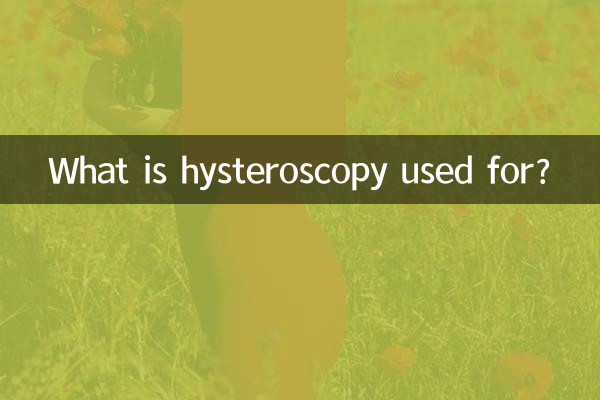What is hysteroscopy used for?
In recent years, with the continuous development of medical technology, hysteroscopy, as a minimally invasive examination method, has gradually become an important tool for the diagnosis and treatment of gynecological diseases. This article will introduce in detail the definition, uses, advantages and related data of hysteroscopy to help readers fully understand this technology.
1. Definition of hysteroscopy

A hysteroscope is an optical instrument inserted into the uterine cavity through the vagina and cervix to directly observe the inside of the uterus. It consists of a lens, a light source and an operating system. It can display images in the uterine cavity in real time and help doctors make accurate diagnosis and treatment.
2. Main uses of hysteroscopy
| Usage classification | Specific applications |
|---|---|
| diagnostic use | Abnormal uterine bleeding, infertility, intrauterine adhesions, uterine malformations, etc. |
| therapeutic use | Endometrial polyp removal, uterine fibroid removal, intrauterine adhesions separation, etc. |
| Other uses | IUD removal, uterine foreign body removal, etc. |
3. Advantages of hysteroscopy
Compared with traditional surgery, hysteroscopy has the following significant advantages:
| Advantages | Description |
|---|---|
| Minimally invasive | No need for laparotomy, little trauma, quick recovery |
| Accuracy | Observe lesions directly to improve diagnostic accuracy |
| security | Fewer complications and shorter hospital stay |
| Versatility | Diagnosis and treatment possible simultaneously |
4. Applicable groups for hysteroscopy
Hysteroscopy is suitable for the following people:
| Crowd type | specific symptoms |
|---|---|
| Patients with abnormal uterine bleeding | Excessive menstrual flow, prolonged menstruation, irregular bleeding, etc. |
| infertility patients | Repeated miscarriage, embryo implantation failure, etc. |
| Suspected uterine cavity lesions | B-ultrasound shows uterine cavity abnormalities, endometrial thickening, etc. |
| Questions about IUDs | IUD incarceration, difficulty in removing the ring, etc. |
5. Precautions for hysteroscopy
Before undergoing hysteroscopy, patients need to pay attention to the following:
| Inspection phase | Things to note |
|---|---|
| Before inspection | Avoid menstrual periods, prohibit sexual intercourse, and improve relevant examinations |
| Under inspection | Relax and cooperate with the doctor |
| After inspection | Pay attention to rest, observe the bleeding situation, and take medication according to the doctor's instructions |
6. Latest developments in hysteroscopy
In recent years, hysteroscopy technology has continued to innovate, and the following new developments have emerged:
| technological progress | Features |
|---|---|
| cold knife hysteroscopy | Avoid electric heating damage and protect the endometrium |
| 3D hysteroscopy | Provides stereoscopic vision and improves surgical accuracy |
| Robot-assisted hysteroscopy | More stable operation and reduced human error |
7. Frequently Asked Questions about Hysteroscopy
We have compiled the following answers to frequently asked questions about hysteroscopy that patients are concerned about:
| question | answer |
|---|---|
| Is hysteroscopy painful? | Most patients only feel slight discomfort and may consider anesthesia |
| How long does the inspection take? | Usually 10-30 minutes, may be longer in complex cases |
| How long does it take to recover after the examination? | Normal activities can usually be resumed in 1-2 days |
| Are there any side effects of hysteroscopy? | A small amount of bleeding or mild abdominal pain may occur |
Conclusion
Hysteroscopy, as an advanced gynecological diagnosis and treatment technology, provides important protection for women's health. With the advancement of medical technology, the application scope of hysteroscopy will continue to expand, bringing good news to more patients. If you have related symptoms, it is recommended to seek medical consultation in time and let a professional doctor evaluate whether a hysteroscopy is needed.

check the details

check the details